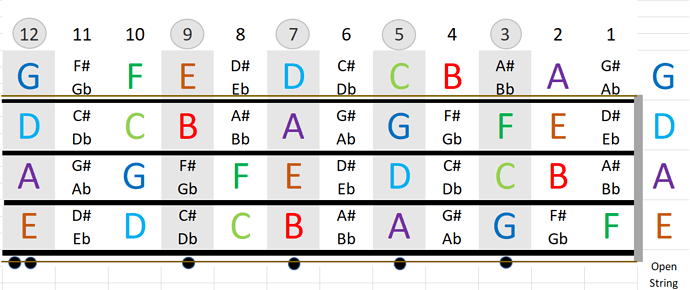Hi. Thank you for taking the time to write all this. I appreciate it. I can relate to what you are saying and being a very visual person (design, photography) it has been a discovery and challenge to do something like this. The chart really helps me to memorize but I challenge myself to “count” the notes. Only practice is going to get me somewhere and I’m right at the point (Module 7) where the theoretical knowledge is more than clear but it’s becoming a real challenge to memorize certain things. And then I’m also very technical and a perfectionist. When Josh explains a melody on the fretboard with the dots I get completely lost but if I look at the tab and hear it, voilá. And I have taken it very seriously not to acquire bad habits and use my pinky, silence strings, etc. On the other hand, I copper shielded my bass, learned how to do a complete setup, etc. I will take your advice and I appreciate it! Thanks again for sharing your obvious experience! (BTW, I also did a lot of print related work) Thanks and Cheers!
Thanks Pam, I ‘need’ all the notes and for me memorizing them means I know where to ‘find’ any tone for any note to make the sound I want at any time, visually. If that makes sense, to you. Wether you use a pattern to find them, use the dotes on your fretboard, use this overview or even counting on every string to get there, to me: you still memorizes how to (find and) play them. Memorizing, to me, is more then only remembering a pattern or remembering what each note is called on the fretboard. For me it includes also muscle memorization, but first and foremost: visualization.
It always depends on your own abilities on how your learning: so I learn visually, I first do need to see where all notes are, using such visual reference, then play aurally and only after that can I use any pattern (which I also have to see first).
Reading your comment, you probably learn in a different way. Which is totally fine and normal as there are at least four different ways to do so. But please, don’t claim or state ‘ You don’t really need to memorize the entire fretboard… ‘ as that definitely isn’t true for all of us, it’s just one of the ways to learn how to play. And I am just one of the persons who do need to 
@RemcoRG what I meant by that statement: you don’t need to memorize the absolute location of each and every note on the board, that comes naturally with practice and note finding exercises such as the Cycle of 4ths. It’s a lot easier just to know their relative location to one another. In other words, just knowing that A is always 2 strings above B, or G is right below C etc. It’s easier to remember the hardware store is across the street from the bakery, and the ice cream shop is 3 doors south of the bakery, than to remember all the exact addresses.
If you want to take the time to memorize the absolute location of each note and that works for you, fine. I’m just offering an alternative method of learning 
Thanks Franx!
Did you update the open string colors and re-post your one with the octave numbers? I’m wanting to print that one. If not, it’s also fine with the black open strings.
I did a 24-fret 4-string version for myself the other day, based on hers, in piano style. All of the naturals are white (including the open strings), and I also removed the #/b text and just made those black.
It’s just a spreadsheet, so not as fancy, but for me it gets the job done.
Not yet @DaveT. I’ll do it today.
I’m good with the @akos version. How lazy am I  .
.
Okay sounds good, that’s one less thing for me to do today ![]()

